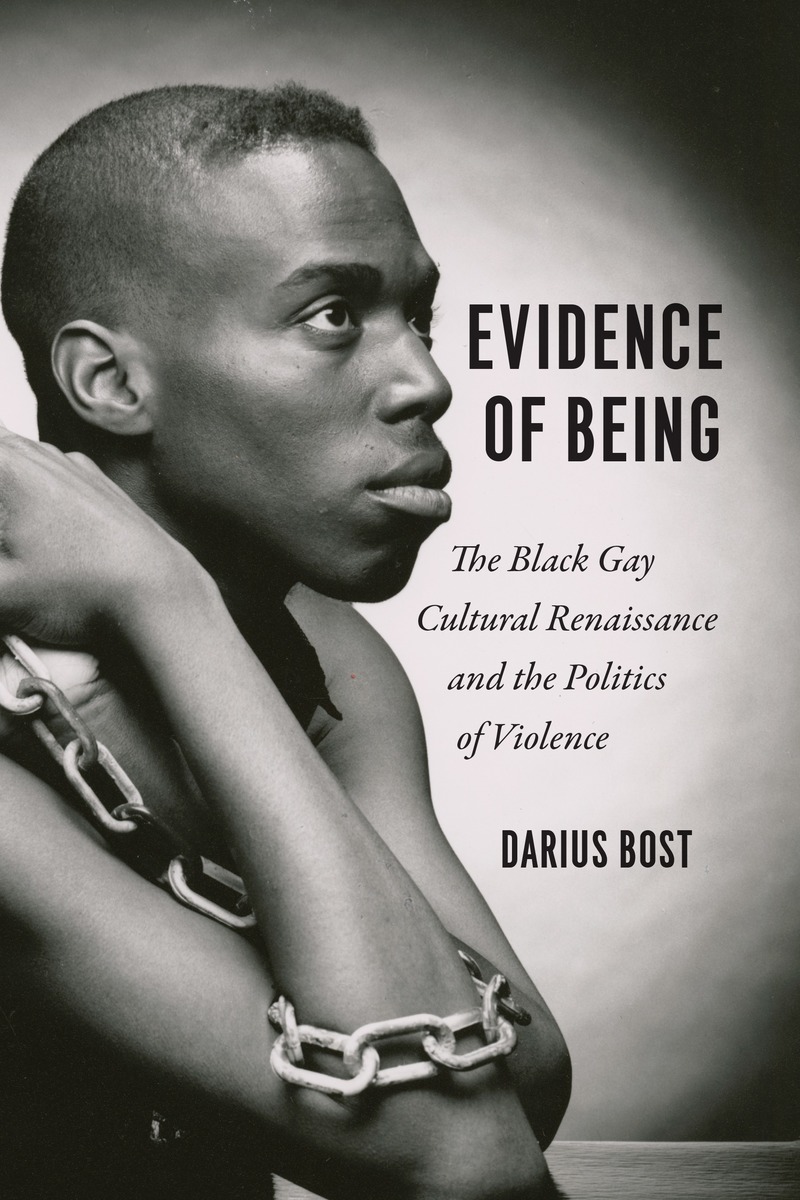Evidence of Being
The Black Gay Cultural Renaissance and the Politics of Violence
University of Chicago Press, 2018
Cloth: 978-0-226-58979-4 | Paper: 978-0-226-58982-4 | Electronic: 978-0-226-58996-1
DOI: 10.7208/chicago/9780226589961.001.0001
Cloth: 978-0-226-58979-4 | Paper: 978-0-226-58982-4 | Electronic: 978-0-226-58996-1
DOI: 10.7208/chicago/9780226589961.001.0001
AVAILABLE FROM
University of Chicago Press (paper, ebook)Apple Books
Barnes & Noble Nook
DeGruyter Multi-User Ebook Program
EBSCO eBooks (formerly NetLibrary)
Google Play
Kobo
ABOUT THIS BOOKAUTHOR BIOGRAPHYREVIEWSTABLE OF CONTENTS
ABOUT THIS BOOK
Evidence of Being opens on a grim scene: Washington DC’s gay black community in the 1980s, ravaged by AIDS, the crack epidemic, and a series of unsolved murders, seemingly abandoned by the government and mainstream culture. Yet in this darkest of moments, a new vision of community and hope managed to emerge. Darius Bost’s account of the media, poetry, and performance of this time and place reveals a stunning confluence of activism and the arts. In Washington and New York during the 1980s and ’90s, gay black men banded together, using creative expression as a tool to challenge the widespread views that marked them as unworthy of grief. They created art that enriched and reimagined their lives in the face of pain and neglect, while at the same time forging a path toward bold new modes of existence. At once a corrective to the predominantly white male accounts of the AIDS crisis and an openhearted depiction of the possibilities of black gay life, Evidence of Being above all insists on the primacy of community over loneliness, and hope over despair.
AUTHOR BIOGRAPHY
Darius Bost is assistant professor of ethnic studies in the School for Cultural and Social Transformation at the University of Utah.
REVIEWS
“Evidence of Being critically and brilliantly moves away from claims about the anti-relational and pessimistic natures of blackness and queerness, doing so with historical attentiveness and theoretical sophistication. There is no book that provides a more comprehensive history of black gay male activism and cultural production in the seventies and eighties than this one.”
— Roderick Ferguson, author of Aberrations in Black“Evidence of Being conjures up late twentieth-century African American struggles for recognition in a society that barely noticed the calamity of the AIDS crisis. Bost assembles an impressive array of original writings and revealing documents that illuminate defiant figures negotiating overlapping structures of prejudice. His book is a black gay interpretive turning point: as readable as it is teachable, as original as it is indispensable.”
— Kevin Mumford, author Not Straight, Not White“Evidence of Being is both a compelling and informative study and an emotionally moving ritual that beckons present and future black fugitive subjects to remember the importance of the literary arts in surviving and thriving against the perils of anti-black and anti-gay violence, politics, and culture. Bost eloquently answers Melvin Dixon’s call to remember ‘with broad vision’ the empowering force of black gay being and cultural imagination.”
— L. H. Stallings, author of Funk the Erotic“Recommended. . . Bost analyzes a renaissance of writing that sparked in these years [1978-1995] a second Harlem Renaissance, although one whose contributors were more openly gay. . . . They wrote to find a way to be, to survive, in the present and the future, if only as literary archive. Bost argues the power of cultural production that sustained “black gay men amid the ubiquitous forms of violence that targeted them.””
— Choice“Moving, theoretically rich, and original. . . . Evidence of Being is an important book that should impact the contours of Black and Queer Studies. Bost’s recuperation of the history of black gay cultural expression opens new lines of inquiry for scholars concerned with black sexuality, loss, history, and memory.”
— Frontiers: A Journal of Women Studies“Darius Bost’s Evidence of Being: The Black Gay Cultural Renaissance and the Politics of Violence is a somber and beautiful engagement with the art and activism of black gay men in the latter decades of the twentieth century...a theoretically sophisticated and intellectually rigorous work that signals Bost’s arrival as a major voice in black literary and cultural studies, ethnic studies, and queer studies.“
— Ashvin R. Kini, Journal of African American History"An exemplary work of cultural studies research, Bodies of Evidence is a dynamic piece of scholarship and a resource for understanding an often marginalized segment of gay history. Although Evidence of Being rigorously engages with contemporary threads in queer studies, it remains accessible to audiences interested in this history of male cultural production and activism. Bost manages to offer alternatives to antirelational and theory-centric turns in queer studies, providing a grounded discussion illustrating the marginalization experienced by gay black artists in the form of state violence, antiblackness, and homophobia while cata-loguing their artistic and activist strategies responding to these forces."
— QED"Darius Bost’s Evidence of Being is an impressive and deeply moving examination of Black gay artistic expression in Washington, D.C., and New York City from the 1970s through the early 1990s that he christens the Black gay renaissance. This era essentially marks the years of the AIDS crisis, although the timing is understood to be somewhat coincidental to the social and political organizing that reached critical mass in D.C. and Baltimore in 1978 with the formation of the National Coalition of Black Gays. With this juncture, Bost combines historical research with close reading of published as well as archived works, focusing on the most recognizable artists of this movement: Essex Hemphill, Joseph Beam, and Melvin Dixon."
— African American ReviewTABLE OF CONTENTS
Introduction / On Black Gay Being
One / The Contradictions of Grief: Violence and Value in Blacklight Magazine
Two / Loneliness: Black Gay Longing in the Work of Essex Hemphill
Three / Postmortem Politics: The Other Countries Collective and Black Gay Mourning
Four / “The Future Is Very Uncertain”: Black Gay Self-Making in Melvin Dixon’s Diaries
